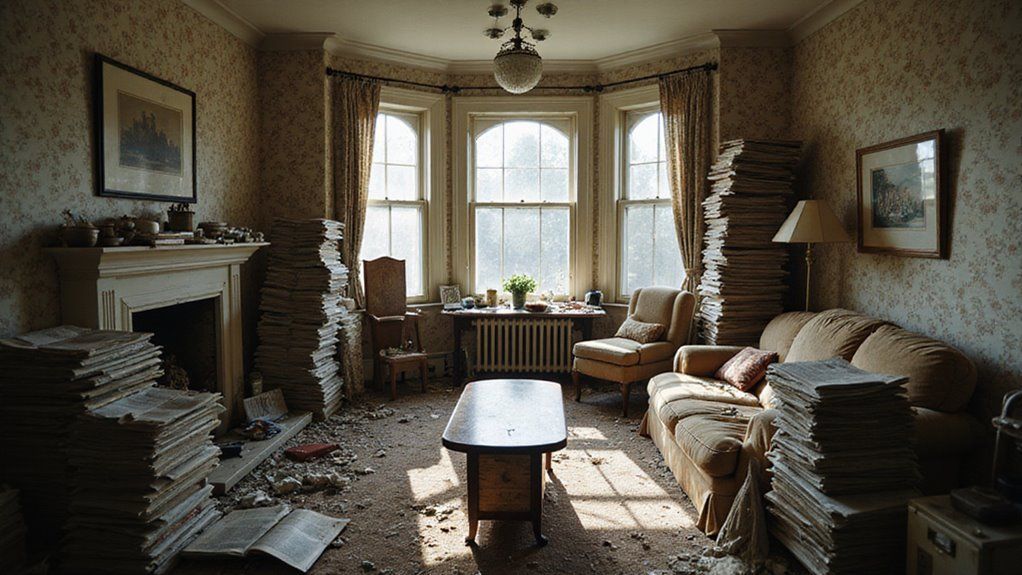Should You Renovate a Hoarder House Before Selling?

Deciding whether to renovate a hoarder house before selling can feel overwhelming. Many homeowners worry about the mess, costs, and time involved. The question is whether fixing it up will bring a better sale or just add stress.
The problem gets worse if the house has major damage or health hazards. Buyers might be scared off, or you might spend more fixing it than you’ll get back. The process can be exhausting, both physically and emotionally.
In most cases, selling a hoarder house as-is is the best option for speed and simplicity. You save time, avoid high costs, and can move on quickly.
Professional buyers or investors often take these homes without requiring repairs. This blog will guide you through the decision and help you choose the right approach for your unique situation.
Key Takeaways
- Renovating a hoarder house typically increases its value and attracts more buyers, but the scope of renovation should match target buyer expectations.
- Deep cleaning and decluttering often provide the highest return on investment, sometimes more than costly upgrades.
- Assess the extent of damage—minor issues may only require cleaning, while severe structural or safety problems need full renovation.
- Consider your budget and timeline; major renovations can be expensive and time-consuming, which may not suit all sellers.
- Always disclose known issues as required by law to avoid legal problems and ensure a smoother sale process.
Understanding Hoarder Houses: What Makes Them Unique
Hoarder houses are different because they have a large amount of items and trash inside. Every area is filled, making it hard to move around or see the space clearly. If you want to understand these homes, notice how the clutter makes them unique.
These houses need special cleanup methods. You should use strong storage options to sort and hold items during the cleaning process.
If you apply simple decluttering techniques, such as sorting by category, the work becomes easier. Additionally, specialized cleaning techniques can help address the health and safety concerns associated with hoarding.
Cleaning a hoarder house is not just regular tidying. You must organize the space so buyers can imagine living there. If you address these issues early, you can make the house more appealing for sale.
Hoarding involves difficulty discarding items and collecting unnecessary objects, which can lead to unsafe and unhealthy living conditions that impact the property's value and sale process.
Evaluating the Severity of the Clutter
You should first check how much clutter is in the house. Walk through each room and look for blocked walkways or stacked items. If rooms are hard to enter, the clutter is severe.
Write down what you see or take photos. These notes help you plan how much work and time you need. If most of the clutter is trash, cleaning will be faster.
Clutter made up of valuables or memories may need careful sorting. Severe hoarding sometimes needs professional cleaners. A good evaluation helps you make better choices during renovation. Additionally, understanding the property condition can influence whether you decide to renovate or sell as-is.
Assessing the Structural and Safety Issues
Before you start any renovations, check for hidden structural damage that clutter may have concealed. You’ll also want to assess the home for mold, pests, and any issues that could impact safety or value. Make sure the property meets all code requirements, as buyers are quick to walk away from costly compliance problems.
Incorporating a staging strategy can help highlight the property's best features and identify areas needing repair before listing. Additionally, consulting with professionals experienced in property evaluation can provide a comprehensive understanding of potential safety hazards and necessary repairs.
Identifying Hidden Structural Damage
Hidden structural damage can be hard to spot after clearing clutter. You should check for issues like sagging floors or cracked walls. Water stains may also signal deeper problems.
Structural problems can delay renovations and increase costs. If ignored, these issues can affect safety and design plans. A qualified inspector should check the foundation, roof, and main walls.
If damage is found early, repairs are easier and less expensive. Early action protects your investment and avoids surprises later. Fixing these problems ensures the home is safe and attractive to buyers.
Evaluating Mold and Pest Risks
Mold and pests are common problems in hoarder houses. If you ignore these risks, your property may lose value and scare away buyers. You should check for them early to avoid surprises during inspection.
A professional mold inspector can find hidden moisture and mold. Pest experts look for signs of rodents, insects, or termites. If either is found, you should address the problem right away.
Remove any damaged materials and treat affected surfaces. Fix leaks and seal entry points to prevent future issues. Always keep records of any work done if you plan to sell the house.
Ensuring Code Compliance Requirements
Renovating a hoarder house requires meeting all building codes and safety rules. If you ignore code compliance, you may face legal issues or struggle to sell the home. Always follow local standards to protect yourself and future occupants.
A licensed inspector can check the house for structural problems and dangerous materials. If they find asbestos, mold, or lead paint, you must remove them before moving forward. These steps make the house safer and help with insurance.
Upgrading electrical, plumbing, and fire safety systems is important in older or neglected homes. If you notice outdated wiring or leaks, you should repair them right away. Fire exits must be clear, and alarms should be installed for safety.
Weighing the Costs of Renovation
You’ll need to estimate cleanup expenses carefully, as these can quickly add up in a hoarder house. Weigh each repair to decide whether it’s more cost-effective to fix or replace, factoring in both labor and materials. By comparing renovation costs with the potential return on your investment, you can make strategic decisions that protect your bottom line.
Additionally, understanding the property's disclosure requirements and legal obligations can help you navigate potential liabilities during the sale process. Considering the costs of repairs involved in clearing out a hoarder house is essential to determine if renovation is financially feasible.
Estimating Cleanup Expenses
Cleanup costs can rise quickly when renovating a hoarder house. You must create a realistic budget before starting any work. Always account for the expense of sorting and removing items first.
Volume of debris affects the total price. If the house is very cluttered, expect higher labor and disposal costs. More items mean more trips and larger dumpsters.
Hazardous materials like mold or pests increase cleanup costs. If you find these issues, you will need special treatments. This work usually costs more and takes longer.
Professional services are often needed for hoarder houses. These crews charge higher rates for difficult jobs. If you want faster results, hiring experts is necessary.
Timeline pressures can also raise expenses. If you have a tight deadline, workers may charge extra for overtime or rush jobs. Planning ahead helps reduce these costs.
Repair Versus Replace
After clearing a hoarder house, you must choose to repair or replace damaged features. Repairs can save money, but replacements often meet modern standards better. Buyers usually prefer newer and safer systems.
Start by checking big things like roofs, plumbing, and electrical parts. If these are badly damaged, replacement is often the best choice. Repairs may work if the damage is minor.
Update paint, flooring, and fixtures if possible. If cabinets or walls are beyond repair, consider replacing them. New finishes can attract more buyers.
Landscaping should not be ignored. Simple fixes like fresh mulch and walkway repairs can improve curb appeal. Full landscaping replacement is only needed if the yard is in very poor shape.
If you consider local market trends, your choices will match buyer expectations. Smart repairs and replacements help your property stand out. Always weigh costs against likely returns before deciding.
Potential Return Analysis
Renovating a hoarder house can affect your profits. A good return analysis helps avoid spending on changes that won't add value. If you want to get the best return, you need to know what upgrades matter most.
Clutter removal often raises a home's value more than fancy upgrades. Buyers usually prefer clean and open spaces. If you focus only on expensive finishes, you might not see a good return.
It is important to consider a few key points. If the renovation cost will not be recovered at sale, it may not be worth it. Local market trends can show which features buyers want most.
If something is badly damaged, full replacement may be needed. Some buyers want move-in ready homes, while others look for fixer-uppers. If you match your upgrades to buyer preferences, you can maximize your profit.
How Hoarder Houses Affect Property Value
Hoarder houses usually lower property value. Buyers see clutter, damage, and mess, which makes the house less attractive. Most people will offer less money for homes in poor condition.
City inspectors may find problems like unsafe wiring or hidden pests. If these issues exist, you might not be able to sell until you fix them. Zoning rules may also require the home to meet certain standards before it can be sold.
If buyers think repairs are expensive or risky, they will pay even less. Comparable homes in better shape are easier to sell and attract higher offers. You should expect a lower appraisal and market value if your house has hoarding issues.
Additionally, property condition significantly impacts the sale process and overall value. Addressing repair costs or making necessary repairs can sometimes increase the home's appeal and value, potentially leading to better offers.
Attracting Traditional Buyers Versus Investors
You'll find that traditional buyers want move-in ready homes and place high value on updated finishes, while investors focus on potential returns and may overlook cosmetic flaws.
Renovations that address safety and livability will attract both groups, but high-end upgrades often matter more to traditional buyers. To maximize your sale price, tailor your renovation strategy to match your ideal buyer’s preferences and expectations.
Carefully price the property to appeal to your target market and ensure it stands out in a competitive listing. Understanding the property condition and how it influences buyer interest can help guide your renovation choices for a more successful sale.
Buyer Expectations and Preferences
Buyers consider renovated hoarder houses if they see value and potential. Their expectations depend on whether they are traditional buyers or investors. Each group looks for different features in the property.
Traditional buyers want a home they can move into right away. They expect modern finishes and neutral colors that appeal to most people. If they see a clean, staged space, they can picture themselves living there.
Investors focus more on the price and future value of the property. Presentation matters less to them than the home’s condition and profit potential. If the renovation is thorough, investors may overlook minor cosmetic issues.
Renovation Impact on Value
Renovations can increase your home's value if done wisely. Buyers often pay more for clean, updated spaces. If you plan to sell, choose improvements that attract your target market.
Traditional buyers want homes that are move-in ready. Adding storage and removing clutter can make your home stand out. These changes can help you sell faster and for a better price.
If you expect to sell to investors, large renovations may not pay off. Investors usually look for homes they can improve themselves. In this case, focus on repairs and a thorough cleaning.
The Emotional and Time Investment Required
Renovating a hoarder house takes a lot of time and emotional energy. You will need patience and a clear plan. If you are not prepared, the process can feel overwhelming.
Renovating a hoarder house demands patience, planning, and emotional strength—it’s easy to feel overwhelmed without proper preparation.
Sorting and decluttering will take many hours. You must decide what to keep, donate, or throw away. If you struggle to let go, this step can be hard. Employing effective decluttering techniques can help manage this challenging task.
Deep cleaning is necessary to make the house safe. You may need professional cleaners for serious messes. If you skip this, health risks can remain.
Renovation oversight needs your close attention. Contractors must be managed to keep the project on track. If you do not monitor progress, delays are likely.
Emotional resilience is also important. Seeing slow progress or facing tough decisions can be stressful. If you prepare yourself, you can handle setbacks better.
Understanding the importance of quick home transactions can help you decide whether to invest in extensive renovations or consider alternative selling options to save time and reduce stress.
Legal and Disclosure Requirements to Consider
You must follow local laws before selling a hoarder house. Sellers usually have to share any known problems with the property. These may include mold, pests, or structural damage. Legal compliance is essential to ensure the sale proceeds smoothly and avoid potential disputes. If you skip required disclosures, the buyer could cancel the sale or sue you.
A real estate lawyer or agent can explain your area’s rules. They will also help you prepare the right paperwork. Ensuring a clear title can further facilitate a smooth transaction by reducing title-related issues that might arise during sale proceedings. Some cities require homes to meet health and safety standards before listing. If your house does not meet these, you might need repairs first. Following these steps helps buyers trust you and can speed up the sale.
Cleaning Versus Full Renovation: What’s Enough?
Cleaning or renovating depends on your goals, budget, and what buyers expect in your area. If the house is safe and mostly clean, deep cleaning and simple fixes may be enough. Renovation is best if there is major damage or buyers want move-in-ready homes.
Start by checking how much clutter and damage exists. Compare your house to similar homes that have sold nearby. If buyers in your market like fixer-uppers, cleaning may be enough.
If cleaning is enough, use smart storage ideas and organize the space. If key areas are too damaged, focus your renovation there. Always let local sales data help you decide.
Working With Real Estate Agents Experienced in Distressed Properties
Working with real estate agents who know distressed properties is important. These agents understand the special problems of selling a hoarder house. They can guide you on what repairs or cleaning are worth doing to help your sale.
Experienced agents in distressed properties can help you navigate the unique challenges of selling a hoarder house and maximize your sale.
A good agent will tell you which fixes help your home sell faster. If you have a low budget, an agent can suggest low-cost ways to improve your house. The right agent will also know how to show your home’s best features.
You should look for agents with experience in selling distressed homes. They should have a strong network of cleaning and storage service providers. Agents who know the local market can set a fair price for your home.
Ask agents how they plan to advertise your home to buyers. If an agent has a good marketing plan, your home will get more attention. Always check how many similar houses the agent has sold before.
Exploring As-Is Sale Options
Selling your hoarder house "as-is" means you can avoid repairs and sell quickly. This option works well if you want a fast, simple sale. You do not need to fix or clean everything.
If you choose this route, focus on cash buyers or investors. These buyers often look for homes that need work. They understand challenges and can close deals quickly.
Even basic cleaning or removing clutter can help your home sell. Buyers may see more value if the house is a little tidier. Small efforts can improve first impressions.
Be ready for a lower appraisal because of the home's condition. Set your price expectations accordingly. If you price too high, buyers may lose interest.
Always share all known issues with potential buyers. Full disclosure builds trust and avoids legal problems. If you are honest, the sale is less likely to fall through.
Impact of Market Conditions on Your Decision
Market conditions affect your choice to renovate or sell your hoarder house as-is. A seller's market can make even neglected homes attract buyers. A buyer's market often favors updated homes with better offers.
Spring and summer usually have more buyers. Winter is slower, so updates may be needed to attract interest. You should watch local trends before deciding when to sell.
If you monitor local real estate data, you can time your sale better. Good timing helps you get the best possible return. Always consider current and seasonal trends before making your decision.
Financing Renovations: What Are Your Options?
Renovating a hoarder house can be costly, so you need to choose the right way to pay for repairs. Good financing helps you complete upgrades and get the most value from your home. If you plan carefully, you can avoid financial stress.
Personal savings let you pay for work without extra fees or debt. Home equity loans or lines of credit use your home’s value and may offer lower interest. If you have enough equity, this can be a smart option.
Renovation loans, such as FHA 203(k), are designed for major home improvements. These loans are helpful if you need to borrow more money. If you meet the loan requirements, you may get better terms.
Credit cards are best for small purchases, but they often charge high interest. If you use credit cards, pay off your balance quickly. Always compare each option’s pros and cons before making a decision.
Case Studies: Outcomes From Renovating vs. Selling As-Is
You need to weigh how renovations can boost your home's value compared to what you’d get selling as-is. Real case studies reveal the profit margins and challenges of each approach. Let’s look at the numbers and outcomes so you can make the smartest choice for your situation.
Renovation Impact on Value
Renovating a hoarder house can raise its value and sale price. Clean, modern homes attract more buyers and better offers. Simple upgrades often make a big difference.
Homes that are renovated may sell for 15–25% more than homes left as-is. Fresh paint, new floors, and kitchen updates add noticeable value. If you choose to upgrade, you may see a strong return.
Storage solutions help small rooms look bigger and more organized. Buyers are more interested when spaces are functional. If you use professional decluttering, you can lower buyer concerns and avoid inspection problems.
As-Is Sale Results
Selling a hoarder house as-is usually leads to a faster sale but at a lower price. Renovating the house can raise its value, but it costs more time and money. Your choice directly affects both profit and how long your house stays on the market.
If you sell as-is, buyers are often investors who pay less but close quickly. Renovating with luxury upgrades can help you get close to full market value, but it takes longer to sell. Simple landscaping or just a cleanout can boost your price a little without much extra time.
You should consider your budget, how fast you want to sell, and how much risk you can handle. If you need money quickly, selling as-is might work best. If you want a higher price and can wait, renovations could be worth it.
Conclusion
If you want to sell a hoarder house, you have options. If you renovate, you might get a higher price, but repairs take time and money. If you sell as-is, you can close faster and avoid extra stress.
If you prefer a quick, simple sale, selling for cash could be the best choice. Many homeowners find this option helpful when they want to move on quickly. Some buyers, like us, specialize in buying homes in any condition.
If you want to sell your hoarder house fast, we can help. We buy houses for cash in Tulsa and handle the process for you. Contact Tulsa Home Buyers today to get started.
This is paragraph text. Click it or hit the Manage Text button to change the font, color, size, format, and more. To set up site-wide paragrapTulsa Home Buyers • August 24, 2025h and title styles, go to Site Theme.
Ready to work with Tulsa Home Buyers?
Let's connect! We’re here to help.
Send us a message and we’ll be in touch.
Or give us a call today at 111-222-3333


